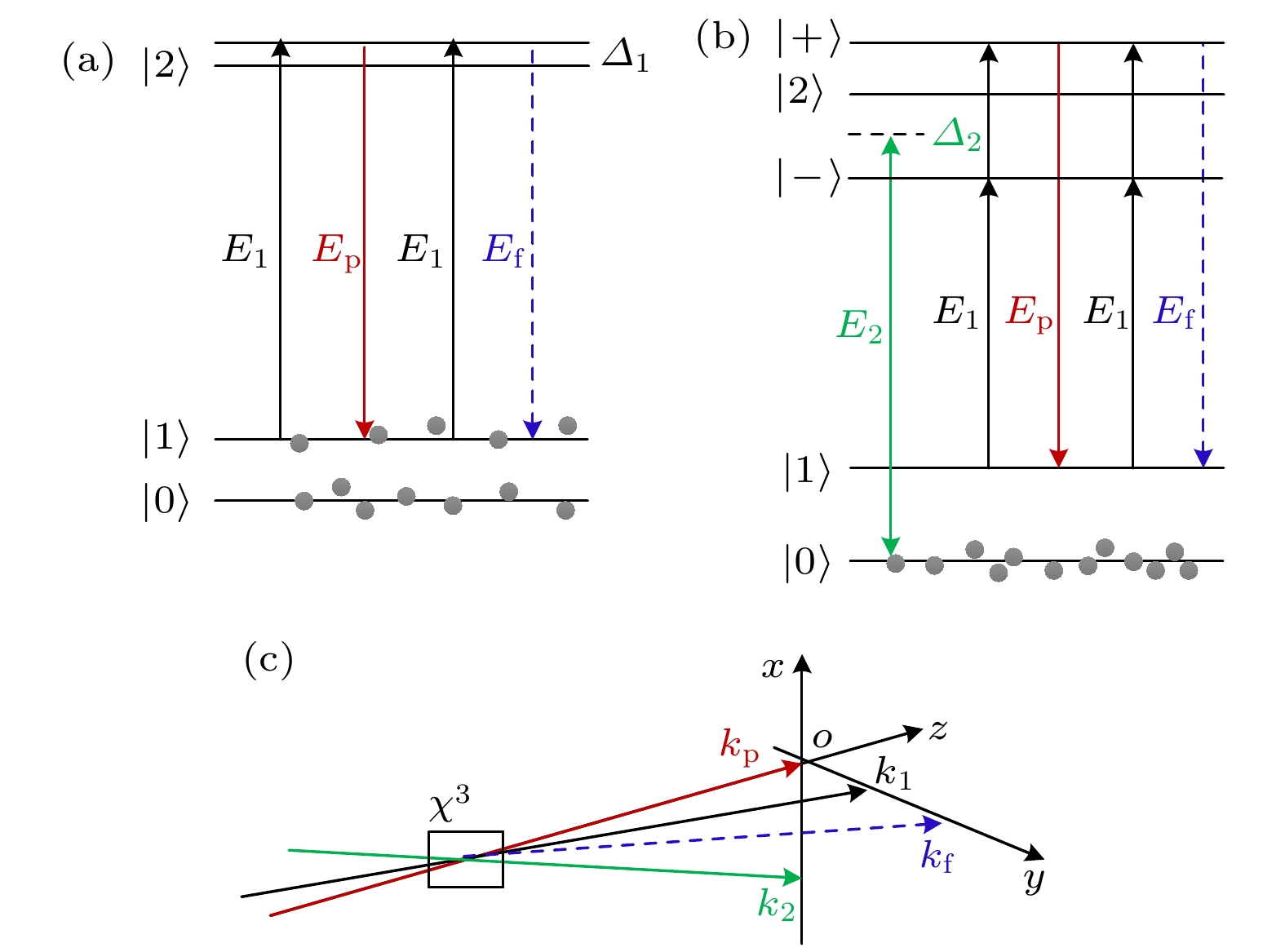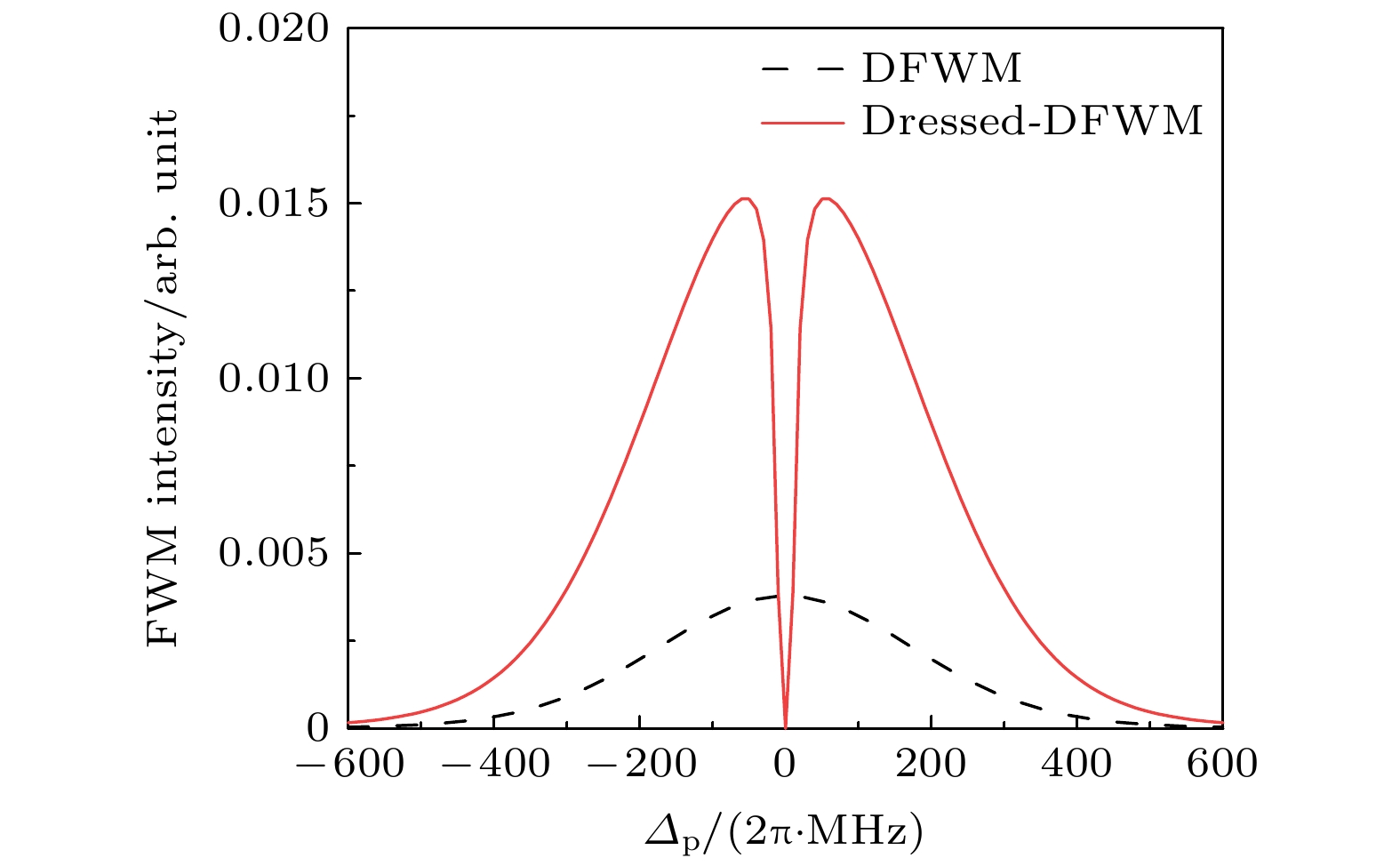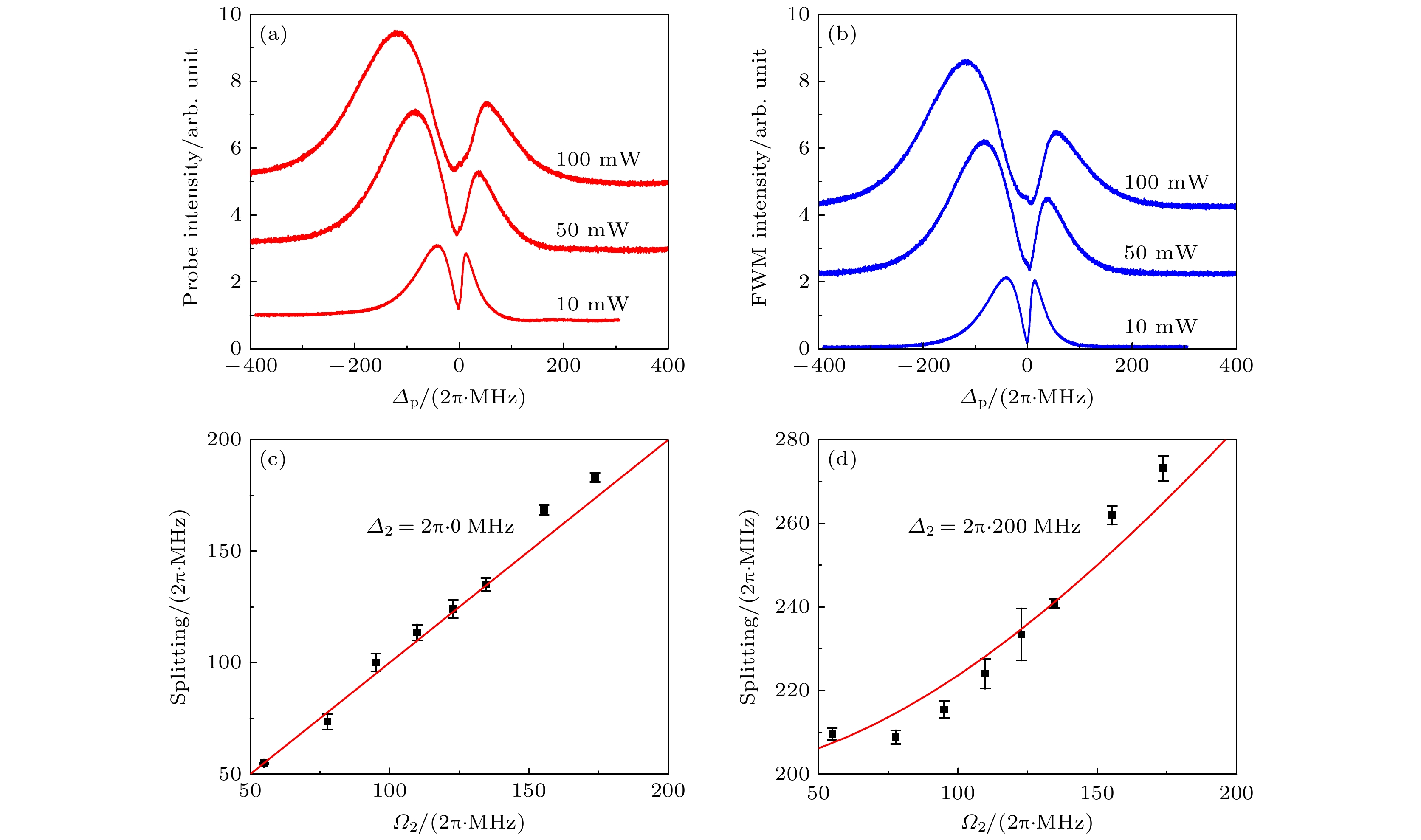-
Focusing on the frequency division multiplexing technology in the applications of large scale optical communication, the double-channel optical gain spectrum with two frequency bands is studied in this paper. The double-channel gain spectrum, named probe channel and four wave mixing channel, comes from a co-propagating degenerate four wave mixing in a hot atomic ensemble. The intention is to divide the gain spectrum into several sub frequency bands through dressed four wave mixing. When a dressed field is exerted on one transition that shares the common excited state with the degenerate four wave mixing, the excited state can experience dressed splitting. It opens two transition paths for the degenerate four wave mixing simultaneously. Because of quantum interference between the two paths, the degenerate four wave mixing are suppressed at two-photon resonance. Consequently, Autler-Townes splitting appears in the gain spectrum, i.e. spectrum is changed from single frequency band into two “M”-type bands. In this paper, the nonlinear density matrix element describing the degenerate (dressed) four wave mixing is solved through perturbation theory, and then the gain spectrum in Doppler broadening atomic medium is plotted, and its Autler-Townes splitting is analyzed by using the dressed-state theory. It shows that the Autler-Townes splitting depends on both the Rabi frequency and single photon detuning of the dressed field. Relevant experiment is performed in cesium vapor at 60 ℃, a pair of high-gain optical spectra with two frequency bands for both double channels is successfully obtained. Moreover, the Autler-Townes splitting as a function of the dressed field intensity and single photon detuning are studied quantitatively. The experimental results accord well with the theoretical predictions. Compared with the degenerate four wave mixing, the atom-field coupled system is changed from an original open two-level into a closed Λ three-level due to the external dressed field, which greatly improves the atomic population on the coherent ground state via optical pumping, and therefore enhancing the gain significantly. This work is important for the field of atom-based optical communication. It provides an optional way of conveying multi-frequency information to the two parallel channels as well as improving the gain of four wave mixing.
-
Keywords:
- degenerate four-wave mixing /
- dressed-state /
- Autler-Townes splitting /
- double-channel with two frequency bands
[1] Lukin M D, Matsko A B, Fleischhauer M, Scully M O 1999 Phys. Rev. Lett. 82 1847
 Google Scholar
Google Scholar
[2] Balic V, Braje D A, Kolchin P, Yin G Y, Harris S E 2005 Phys. Rev. Lett. 94 183601
 Google Scholar
Google Scholar
[3] McCormick C F, Boyer V, Arimondo E, Lett P D 2007 Opt. Lett. 32 178
 Google Scholar
Google Scholar
[4] Motomura K, Tsukamoto M, Wakiyama A, Harada K, Mitsunaga M 2005 Phys. Rev. A 71 043817
 Google Scholar
Google Scholar
[5] Guo M J, Zhou H T, Wang D, Gao J R, Zhang J X, Zhu S Y 2014 Phys. Rev. A 83 033813
[6] Ma R, Liu W, Qin Z Z, Jia X J, Gao J R 2017 Phys. Rev. A 96 043843
 Google Scholar
Google Scholar
[7] Swaim J D, Glasser R T 2017 Phys. Rev. A 96 033818
 Google Scholar
Google Scholar
[8] Wang D, Hu L Y, Pang X M, Zhang J X, Zhu S Y 2013 Phys. Rev. A 88 042314
 Google Scholar
Google Scholar
[9] Qin Z Z, Cao L M, Wang H L, Marino A M, Zhang W P, Jing J T 2014 Phys. Rev. Lett. 113 023602
 Google Scholar
Google Scholar
[10] Boyer V, Marino A M, Lett P D 2008 Phys. Rev. Lett. 100 143601
 Google Scholar
Google Scholar
[11] Pan X Z, Yu S, Zhou Y F, Zhang K, Zhang K, Lv S C, Li S J, Wang W, Jing J T 2019 Phys. Rev. Lett. 123 070506
 Google Scholar
Google Scholar
[12] Boyer V, McCormick C F, Arimondo E, Lett P D 2007 Phys. Rev. Lett. 99 143601
 Google Scholar
Google Scholar
[13] Jing J T, Zhou Z F, Liu C J, Qin Z Z, Fang Y M, Zhou J, Zhang W P 2014 Appl. Phys. Lett. 104 151103
 Google Scholar
Google Scholar
[14] Pooser R C, Marino A M, Boyer V, Jones K M, Lett P D 2009 Phys. Rev. Lett. 103 010501
 Google Scholar
Google Scholar
[15] Kong J, Hudelist F, Ou Z Y, Zhang W P 2013 Phys. Rev. Lett. 111 033608
 Google Scholar
Google Scholar
[16] Hudelist F, Kong J, Liu C J, Jing J T, Ou Z Y, Zhang W P 2014 Nat. Commun. 5 3049
 Google Scholar
Google Scholar
[17] Liu W, Ma R, Zeng L, Qin Z Z, Su X L 2019 Opt. Lett. 44 2053
 Google Scholar
Google Scholar
[18] Zhou H T, Li R F, Dai Y P, Wang D, Wu J Z, Zhang J X 2019 J. Phys. B: At. Mol. Opt. Phys. 52 185002
 Google Scholar
Google Scholar
[19] Zhang Y P, Xiao M 2007 Opt. Express 15 7182
 Google Scholar
Google Scholar
[20] Zuo Z C, Sun J, Liu X, Wu L A, Fu P M 2007 Phys. Rev. A 75 023805
 Google Scholar
Google Scholar
[21] Zhang Y P, Anderson B, Xiao M 2008 J. Phys. B: At. Mol. Opt. Phys. 41 045502
 Google Scholar
Google Scholar
[22] Li C B, Zheng H B, Zhang Y P, Nie Z Q, Song J P, Xiao M 2009 Appl. Phys. Lett. 95 041103
 Google Scholar
Google Scholar
[23] 李祥, 李培英 2015 激光与光电子学进展 52 051901
 Google Scholar
Google Scholar
Li X, Li P Y 2015 Las. Optoelect. Prog. 52 051901
 Google Scholar
Google Scholar
[24] 桑苏玲 2019 激光与光电子学进展 56 081901
 Google Scholar
Google Scholar
Sang S L 2019 Las. Optoelect. Prog. 56 081901
 Google Scholar
Google Scholar
[25] Su J J, Yu I A 2003 Chin. J. Phys. 41 627
[26] Novikova I, Matsko A B, Welch G R 2002 J. Mod. Opt. 49 2565
 Google Scholar
Google Scholar
[27] Grischkowsky D 1970 Phys. Rev. Lett. 24 866
 Google Scholar
Google Scholar
-
图 2 FWM强度增益谱的理论模拟曲线, 其中虚线为DFWM, 实线为dressed-DFWM, 使用参数为:
${\varOmega _1} \!=\! {\varOmega _2} \!=\! 2{\text{π}} \cdot 110\;{\rm{MHz}}$ ,${\varOmega _{\rm{p}}} = 2{\text{π}} \cdot 10\;{\rm{MHz}}$ ,${\varGamma _{10}} = 2{\text{π}} \cdot 1\; {\rm{kHz}}$ ,${\varGamma _{21}} = {\varGamma _{11}} = 2{\text{π}} \cdot 4.6 $ $ \;{\rm{MHz}}$ ,$T = 60 \;{ ^ \circ }{\rm{C}}$ Figure 2. The theoretical curves of FWM intensity gain spectrum, the dashed curve is for the DFWM, and the solid curve is for the dressed-DFWM. The parameters:
${\varOmega _1} = {\varOmega _2} = 2{\text{π}} \cdot 110\;{\rm{MHz}}$ ,${\varOmega _{\rm{p}}} = 2{\text{π}} \cdot 10\;{\rm{MHz}}$ ,${\varGamma _{10}} = 2{\text{π}} \cdot 1 $ $ \; {\rm{kHz}}$ ,${\varGamma _{21}} = {\varGamma _{11}} = 2{\text{π}} \cdot 4.6\;{\rm{MHz}}$ ,$T = 60 \;{ ^ \circ }{\rm{C}}$ .图 4 光斑图样与增益谱线 (a), (b) 关闭泵浦场
${E_1}$ 时的EIT效应; (c), (d) 关闭缀饰场${E_2}$ 时的DFWM效应; (e), (f)${E_1}$ ,${E_2}$ 同时打开时的Dressed-DFWM效应. 实验参数: 泵浦场光功率${P_1} = 40 \;{\rm{ mW}}$ , 缀饰场光功率${P_2} = 40 \;{\rm{ mW}}$ , 缀饰场失谐$ {\varDelta _2} = 0$ Figure 4. Laser beams’ pattern and gain spectrum: (a), (b) the EIT effect when the pump field
${E_1}$ is turned off; (c), (d) the DFWM effect when the dressed field${E_2}$ is turned off; (e), (f) the Dressed-DFWM effect when both${E_1}$ and${E_2}$ are turned on. Experimental parameters: the pump field power:${P_1} = 40 \;{\rm{ mW}}$ , the dressed field power:${P_2} = 40\;{\rm{ mW}}$ , the dressed field detuning$ {\varDelta _2} = 0$ .图 5 缀饰场失谐
$ {\varDelta _2}$ 分别为 (i) 0, (ii)$ 2{\text{π}} \cdot 100 \;{\rm{MHz}}$ 以及 (iii)$ 2{\text{π}} \cdot 200 \;\;{\rm{MHz}}$ 的增益谱 (a) 探测光信道${E_{\rm{p}}}$ ; (b) DFWM光信道${E_{\rm{f}}}$ . 实验参数:${P_1} = 40 \;{\rm{mW}}$ ,${P_2} = 40 \;{\rm{mW}}$ ,${P_{\rm{p}}} = 30\;{\rm{\text{μ} W}}$ Figure 5. Gain spectrum with dressed field detuning
$ {\varDelta _2}$ at (i)$ 0$ , (ii)$ 2{\text{π}} \cdot 100 \;{\rm{MHz}}$ , and (iii)$ 2{\text{π}} \cdot 200 \;\;{\rm{MHz}}$ : (a) The probe channel${E_{\rm{p}}}$ ; (b) the DFWM channel${E_{\rm{f}}}$ . Experimental parameters:${P_1} = 40 \;{\rm{mW}}$ ,${P_2} = 40 \;{\rm{mW}}$ ,${P_{\rm{p}}} = 30\;{\rm{\text{μ} W}}$ .图 6 (a), (b) 固定
$ {\varDelta _2} = 0$ 时缀饰场功率$P_2$ 分别为 (i)$ 10\;{\rm{mW}}$ , (ii)$ 50\;{\rm{mW}}$ 以及 (iii)$ 100\;{\rm{mW}}$ 的增益谱 (a)${E_{\rm{p}}}$ 信道; (b)${E_{\rm{f}}}$ 信道; (c), (d) AT 分裂间距随缀饰场拉比频率变化的关系曲线: (c)$ {\varDelta _2} = 0$ , (d)$ {\varDelta _2} = 2{{\pi}} \cdot 200\;{\rm{MHz}}$ . 实验参数:${P_1} \!=\! 40 \;{\rm{mW}}$ ,${P_{\rm{p}}} \!=\! 30 \;{\rm{\text{μ}W}}$ Figure 6. (a, b) Gain spectrum with dressed power at (i)
$ 10\;{\rm{mW}}$ , (ii)$ 50\;{\rm{mW}}$ , and (iii)$ 100\;{\rm{mW}}$ when$ {\varDelta _2} = 0$ . (a) The${E_{\rm{p}}}$ channel; (b) the${E_{\rm{f}}}$ channel; (c), (d) the curves for the AT splitting versus the dressed field’s Rabi frequencies: (c)$ {\varDelta _2} = 0$ , (d)$ {\varDelta _2} = $ $ 2{\text{π}} \cdot 200\;{\rm{MHz}}$ . Experimental parameters:${P_1} = 40 \;{\rm{mW}}$ ,${P_{\rm{p}}} = 30 \;{\rm{\text{μ} W}}$ . -
[1] Lukin M D, Matsko A B, Fleischhauer M, Scully M O 1999 Phys. Rev. Lett. 82 1847
 Google Scholar
Google Scholar
[2] Balic V, Braje D A, Kolchin P, Yin G Y, Harris S E 2005 Phys. Rev. Lett. 94 183601
 Google Scholar
Google Scholar
[3] McCormick C F, Boyer V, Arimondo E, Lett P D 2007 Opt. Lett. 32 178
 Google Scholar
Google Scholar
[4] Motomura K, Tsukamoto M, Wakiyama A, Harada K, Mitsunaga M 2005 Phys. Rev. A 71 043817
 Google Scholar
Google Scholar
[5] Guo M J, Zhou H T, Wang D, Gao J R, Zhang J X, Zhu S Y 2014 Phys. Rev. A 83 033813
[6] Ma R, Liu W, Qin Z Z, Jia X J, Gao J R 2017 Phys. Rev. A 96 043843
 Google Scholar
Google Scholar
[7] Swaim J D, Glasser R T 2017 Phys. Rev. A 96 033818
 Google Scholar
Google Scholar
[8] Wang D, Hu L Y, Pang X M, Zhang J X, Zhu S Y 2013 Phys. Rev. A 88 042314
 Google Scholar
Google Scholar
[9] Qin Z Z, Cao L M, Wang H L, Marino A M, Zhang W P, Jing J T 2014 Phys. Rev. Lett. 113 023602
 Google Scholar
Google Scholar
[10] Boyer V, Marino A M, Lett P D 2008 Phys. Rev. Lett. 100 143601
 Google Scholar
Google Scholar
[11] Pan X Z, Yu S, Zhou Y F, Zhang K, Zhang K, Lv S C, Li S J, Wang W, Jing J T 2019 Phys. Rev. Lett. 123 070506
 Google Scholar
Google Scholar
[12] Boyer V, McCormick C F, Arimondo E, Lett P D 2007 Phys. Rev. Lett. 99 143601
 Google Scholar
Google Scholar
[13] Jing J T, Zhou Z F, Liu C J, Qin Z Z, Fang Y M, Zhou J, Zhang W P 2014 Appl. Phys. Lett. 104 151103
 Google Scholar
Google Scholar
[14] Pooser R C, Marino A M, Boyer V, Jones K M, Lett P D 2009 Phys. Rev. Lett. 103 010501
 Google Scholar
Google Scholar
[15] Kong J, Hudelist F, Ou Z Y, Zhang W P 2013 Phys. Rev. Lett. 111 033608
 Google Scholar
Google Scholar
[16] Hudelist F, Kong J, Liu C J, Jing J T, Ou Z Y, Zhang W P 2014 Nat. Commun. 5 3049
 Google Scholar
Google Scholar
[17] Liu W, Ma R, Zeng L, Qin Z Z, Su X L 2019 Opt. Lett. 44 2053
 Google Scholar
Google Scholar
[18] Zhou H T, Li R F, Dai Y P, Wang D, Wu J Z, Zhang J X 2019 J. Phys. B: At. Mol. Opt. Phys. 52 185002
 Google Scholar
Google Scholar
[19] Zhang Y P, Xiao M 2007 Opt. Express 15 7182
 Google Scholar
Google Scholar
[20] Zuo Z C, Sun J, Liu X, Wu L A, Fu P M 2007 Phys. Rev. A 75 023805
 Google Scholar
Google Scholar
[21] Zhang Y P, Anderson B, Xiao M 2008 J. Phys. B: At. Mol. Opt. Phys. 41 045502
 Google Scholar
Google Scholar
[22] Li C B, Zheng H B, Zhang Y P, Nie Z Q, Song J P, Xiao M 2009 Appl. Phys. Lett. 95 041103
 Google Scholar
Google Scholar
[23] 李祥, 李培英 2015 激光与光电子学进展 52 051901
 Google Scholar
Google Scholar
Li X, Li P Y 2015 Las. Optoelect. Prog. 52 051901
 Google Scholar
Google Scholar
[24] 桑苏玲 2019 激光与光电子学进展 56 081901
 Google Scholar
Google Scholar
Sang S L 2019 Las. Optoelect. Prog. 56 081901
 Google Scholar
Google Scholar
[25] Su J J, Yu I A 2003 Chin. J. Phys. 41 627
[26] Novikova I, Matsko A B, Welch G R 2002 J. Mod. Opt. 49 2565
 Google Scholar
Google Scholar
[27] Grischkowsky D 1970 Phys. Rev. Lett. 24 866
 Google Scholar
Google Scholar
Catalog
Metrics
- Abstract views: 3765
- PDF Downloads: 106
- Cited By: 0















 DownLoad:
DownLoad:






































































